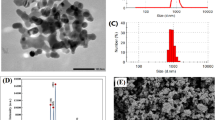Abstract
Multiple myeloma is defined as bone marrow contains higher level of plasma cells, and well-known malignant tumour of B lymphocytes. Recently, nanoparticles have been synthesised and applied in the field of biomedicine. RPMI8226 cells were treated with selenium nanoparticles (SeNPs) at various concentrations for 48 h. Cell viability, reactive oxygen species (ROS), cell morphology, ATP level, apoptosis, and caspase-3 and caspase-9 expressions were determined. RPMI8226 cell viability was reduced 4.7%, 11.3%, 32.7%, 48.6% and 60.3% at 20–100 µg/ml of SeNPs respectively. Intracellular ROS level was increased in RPMI8226 cells 31.9%, 86%, 167% and 313.6% at 40–100 µg/ml of SeNPs respectively. ATP level was reduced in RPMI8226 cells 15.8%, 32.6%, 48.3% and 55.5% at 40–100 µg/ml of SeNPs respectively. Higher concentration of SeNPs showed nuclear coagulation, cell contraction, and more cell debris were noted with increased concentration of SeNPs, and dose-dependent relationship was observed. Apoptosis of RPMI8226 cells increased with increased concentration of SeNPs. SeNPs also increased mRNA and protein expression of caspase-3 and caspase-9 in RPMI8226 cells. Taking all these data together, it is concluded that the SeNPs could effectively induce apoptosis, and cell death of multiple myeloma cells.









Similar content being viewed by others
References
M. Rossi, C. Botta, M. Arbitrio, R. D. Grembiale, P. Tagliaferri, and P. Tassone (2018). Oncotarget 9, 20119.
L. Y. Cruz, D. Wang, and J. Liu (2019). J. Photochem. Photobiol. B 191, 123.
S. T. Lwin, C. M. Edwards, and R. Silbermann (2016). Bonekey Rep. 5, 772.
D. Kazandjian (2016). Semin. Oncol. 43, 676.
N. A. Duggett and S. J. L. Flatters (2017). Br. J. Pharmacol. 174, 4812.
H. Liu, R. Xu, and H. Huang (2016). Exp. Ther. Med. 12, 3041.
D. M. Rozewski, S. E. Herman, and W. H. Towns (2012). AAPS J. 14, 872.
P. Sonneveld (2017). Hematol. Am. Soc. Hematol. Educ. Prog. 2017, 508.
R. Raliya, T. Singh Chadha, K. Haddad, and P. Biswas (2016). Curr. Pharm. Des. 22, 2481.
H. Bahadar, F. Maqbool, K. Niaz, and M. Abdollahi (2016). Iran Biomed. J. 20, 1.
A. Khurana, S. Tekula, M. A. Saifi, P. Venkatesh, and C. Godugu (2019). Biomed. Pharmacother. 111, 802.
S. Skalickova, V. Milosavljevic, K. Cihalova, P. Horky, L. Richtera, and V. Adam (2017). Nutrition 33, 83.
H. Steinbrenner, and H. Sies (2009). Acta (BBA)-Gen. 1790, 1478.
A. V. Tugarova, P. V. Mamchenkova, and Y. A. Dyatlova (2018). Spectrochim. Acta A 192, 458.
H. C. Winkler, M. Suter, and H. Naegeli (2016). J. Nanobiotechnol. 14, 44.
P. Sonkusre and S. S. Cameotra (2017). J. Nanobiotechnol. 15, 43.
G. Huang, Z. Liu, L. He, K. H. Luk, S. T. Cheung, and K. H. Wong (2018). Biomater. Sci. 2018, 2508.
P. Muthuraman, G. Enkhtaivan, M. Bhupendra, M. Chandrasekaran, N. Rafi, and D. H. Kim (2016). Saudi J. Biol. Sci. 23, 503.
G. Zhao, R. Dong, J. Teng, L. Yang, T. Liu, X. Wu, Y. He, Z. Wang, H. Pu, and Y. Wang (2020). ACS Omega 5, 11710.
M. Marvibaigi, N. Amini, and E. Supriyanto (2016). PLoS ONE 11, e0158942.
Z. Li, D. Guo, X. Yin, S. Ding, M. Shen, R. Zhang, Y. Wang, and R. Xu (2020). Biomed. Pharmacother. 122, 109712.
J. Bai and Z. Meng (2010). Environ. Mol. Mutagen. 51, 112.
G. Purushotham, Y. Padma, and Y. Nabiha (2016). 3 Biotech. 6, 212.
M. Esghaei, H. Ghaffari, B. Rahimi Esboei, Z. Ebrahimi Tapeh, F. Bokharaei Salim, and M. Motevalian (2018). Asian Pac. J. Cancer Prev. 19, 1697.
K. Scott, P. J. Hayden, A. Will, K. Wheatley, and I. Coyne (2016). Cochrane Database Syst. Rev. 4, CD010816.
J. Abdi, G. Chen, and H. Chang (2013). Oncotarget 4, 2186–2207.
H. Li, D. Liu, S. Li, and C. Xue (2019). Int. J. Biol. Macromol. 129, 818.
J. Tian, X. Wei, W. Zhang, and A. Xu (2020). Front. Bioeng. Biotechnol. 8, 598997.
L. Wang, C. Li, Q. Huang, and X. Fu (2019). Food Funct. 10, 539.
Z. Li, B. Ding, X. Zhou, and G. L. Wang (2017). PLoS Pathog. 13, e1006157.
V. Gangadevi, S. Thatikonda, V. Pooladanda, G. Devabattula, and C. Godugu (2021). J. Nanobiotechnol. 19, 101.
G. Liao, J. Tang, and D. Wang (2020). World J. Surg. Oncol. 18, 81.
V. Sharma, S. K. Singh, D. Anderson, D. J. Tobin, and A. Dhawan (2011). J. Nanosci. Nanotechnol. 11, 3782.
R. K. Shukla, V. Sharma, A. K. Pandey, S. Singh, S. Sultana, and A. Dhawan (2010). Toxicol. In Vitro 25, 231.
D. Iannazzo, R. Ettari, S. Giofrè, A. H. Eid, and A. Bitto (2020). Cancers (Basel) 12, 3144.
Author information
Authors and Affiliations
Contributions
LL conceived and designed research. YG and WZ performed experiments and performed statistical analysis. YZ wrote the manuscript. All authors read and approved the final manuscript.
Corresponding author
Ethics declarations
Conflict of interest
All authors declare that they have no conflicts of interest.
Additional information
Publisher's Note
Springer Nature remains neutral with regard to jurisdictional claims in published maps and institutional affiliations.
Rights and permissions
About this article
Cite this article
Li, L., Gao, Y., Zhang, W. et al. Antitumor Potential of Selenium Nanoparticles (SeNPs) Against Multiple Myeloma Model in RPMI8226 Cells. J Clust Sci 33, 2771–2780 (2022). https://doi.org/10.1007/s10876-021-02191-5
Received:
Accepted:
Published:
Issue Date:
DOI: https://doi.org/10.1007/s10876-021-02191-5




